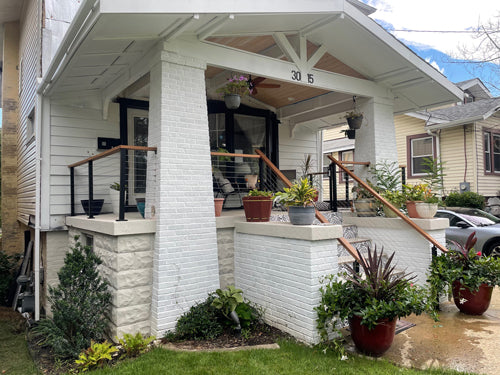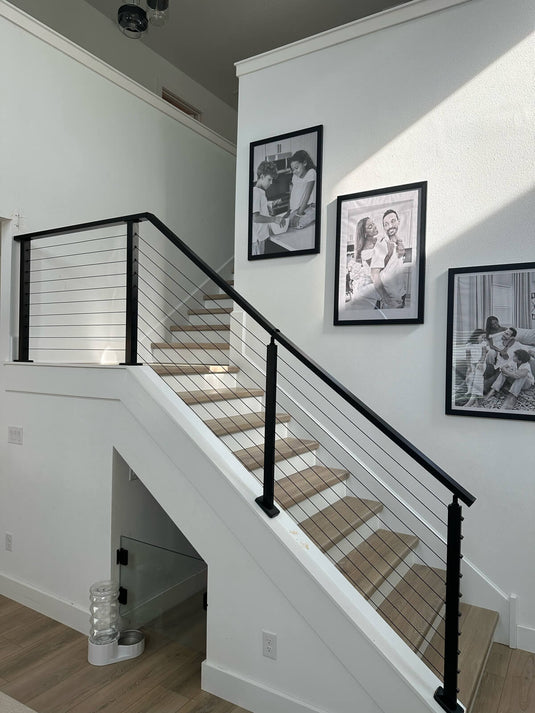TABLE OF CONTENTS
Do You Know the Guardrail Height Standards for Cable Railings?
When designing a deck, the safety and functionality of the cable railing system are among the most critical considerations. Before you dive into your next home improvement project, have you confirmed the guardrail height standards? It's important to note that railing height codes may vary by location, so understanding your local standards is essential. This article will explore key aspects of railing height regulations, safety and aesthetic considerations and practical tips for selecting the right height for your cable railing project.

Photo Credit: Ryan Hieb / Muzata Customer
Guardrail Height Standards for Cable Railings
‒ Deck rails (or guardrails) are barriers along elevated surfaces like decks, balconies, or porches to prevent falls. Cable railings, with their horizontal cables, are a popular choice for decks.
‒ Handrails are graspable rails along staircases or ramps, providing support during ascent or descent. In some designs, cable railings may incorporate a handrail component.
|
Deck Rail Height |
Typical Handrail Height |
|
|
Standards |
|
|
The following text is sourced from the 2024 International Residential Code (IRC) and applies to small residential structures, including single-family and multi-family homes. (In the IRC, "guards" is the term used for "railings.")
Guards shall be provided for those portions of open-sided walking surfaces, including floors, stairs, ramps and landings that are located more than 30 inches (762 mm) measured vertically to the floor or grade below at any point within 36 inches (914 mm) horizontally to the edge of the open side. Insect screening shall not be considered as a guard.
Required guards at open-sided walking surfaces, including stairs, porches, balconies or landings, shall be not less than 36 inches (914 mm) in height as measured vertically above the adjacent walking surface or the line connecting the nosings.
Exceptions:
- Guards on the open sides of stairs shall have a height of not less than 34 inches (864 mm) measured vertically from a line connecting the nosings.
- Where the top of the guard serves as a handrail on the open sides of stairs, the top of the guard shall be not less than 34 inches (864 mm) and not more than 38 inches (965 mm) as measured vertically from a line connecting the nosings.
Please note that this regulation may be affected by your local building codes, which may impose stricter requirements. For example, in areas with special safety concerns, railings might even be required for decks lower than 30 inches (approximately 76 cm). Additionally, decks near pools, stairs, or elevated structures may have other restrictions. Even if not mandatory, you might still need to install railings. Falling from a height of 30 inches can still cause injury, especially if the surface below the deck is made of tough materials.
Risks of Incorrect Guardrail Heights
Choosing the wrong railing height for your cable railing can compromise safety, whether it's too high or too low. Here's why getting it right matters:
|
Too Low |
|
|
Too High |
|
|
Cable-Specific Concerns: |
|
Height's Impact on Aesthetic Perspective
Cable railings are prized for their minimalist, open look, but guardrail height plays a big role in achieving the desired aesthetic:
🔍Visual Transparency:
-
A 36-inch deck rail height maximizes openness, preserving views from your deck or balcony—perfect for homes with scenic surroundings, like lakefront or mountain properties.
-
A 42-inch height, common in commercial settings, may slightly reduce transparency but can enhance privacy in urban environments.
-
Design Tip: Pair cable railings with stainless steel posts to maintain a clean, unobstructed look.
🔍Spatial Perception:
-
Lower railings (36 inches) make small decks or balconies feel larger and more inviting by reducing visual barriers.
-
Taller railings (42 inches) can create a sense of enclosure, which may feel restrictive on compact decks but add sophistication in larger spaces.
-
Example: A 36-inch cable railing on a 10x10-foot deck keeps the space airy, while a 42-inch railing on a spacious rooftop deck adds a modern, defined edge.
🔍Aesthetic Integration:
-
Cable railings complement modern and industrial designs, with height influencing the overall vibe. A 36-inch height feels casual and open, while 42 inches leans formal and structured.
-
The top rail material (wood, metal, or composite) and finish (polished, matte, or powder-coated) should harmonize with the height to tie the design together.
-
DIY Note: Mock up your railing height with temporary posts or string to visualize the aesthetic impact before committing to installation.

Photo Credit: David Windley / Muzata Customer
Selection Recommendations
Selecting the ideal railing height for your cable railing depends on your project's context—residential or commercial, deck or staircase, and aesthetic goals. Here are tailored recommendations:
🔍Residential Decks:
-
Height: Minimum 36 inches (IRC-compliant).
-
Tips: Choose 36 inches for scenic decks to prioritize views. Ensure cables are spaced less than 4 inches apart for child safety. Stainless steel cables with wood or aluminum top rails offer durability and style.
-
Example: A lakeside home's deck with a 36-inch cable railing preserves the water view while meeting safety codes.
🔍Commercial Decks or Balconies:
-
Height: Minimum 42 inches (IBC-compliant).
-
Tips: Opt for 42 inches in high-traffic areas like restaurants or offices. Use sturdy materials like powder-coated aluminum to withstand wear. Consider taller posts for added visual weight in large spaces.
-
Example: A rooftop café with a 42-inch cable railing ensures safety for patrons while maintaining a chic, open vibe.
🔍Staircases (Residential or Commercial):
-
Height: 34–38 inches for handrails; 36–42 inches for guardrails if the staircase has an elevated landing.
-
Tips: Install a graspable top rail at 34–38 inches for stairs, and add a separate guardrail if needed. Ensure cable tension meets IRC/IBC load requirements (typically 200 pounds of force).
-
Example: A residential staircase with a 36-inch cable guardrail and a 34-inch wood handrail blends safety and elegance.
🔍DIY Considerations:
-
Measure Twice: Confirm your deck's height above grade to determine if guardrails are required (over 30 inches triggers IRC rules).
-
Check Local Codes: Some areas require permits or inspections for railing installations. Contact your local building department before starting.
-
Tools and Materials: Invest in a cable tensioning tool and high-quality fittings to ensure a professional finish. Pre-drilled posts simplify installation for DIYers.
Conclusion

Photo Credit: Dylan Hanson / Muzata Customer
Installing cable railings is an exciting way to elevate your deck or staircase, but knowing the guardrail height standards is the first step to a successful project. By adhering to deck railing height codes—36 inches for residential decks, 42 inches for commercial spaces, and 34–38 inches for handrails—you ensure safety and compliance. Beyond regulations, the right railing height balances safety risks, like falls or climbing hazards, with aesthetic goals, such as preserving views or enhancing spatial openness. Whether you're a homeowner dreaming of a scenic deck, a contractor ensuring code compliance, or a DIY enthusiast tackling a weekend project, these guidelines empower you to make informed decisions. So, before you install those cables, double-check your heights, verify local codes, and create a space that's as safe as it is stunning.
📌Got it all clear? Get expert advice now for your cable railing project!




